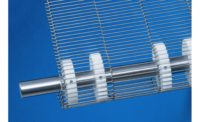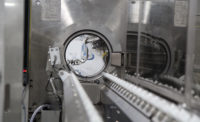In meat processing, lightweight wire conveyor belting is a workhorse of the industry, commonly used to transfer product between stations for baking, cooking, coating, and frying as well as breading and battering.
Because such processing (and further processing for fully prepared meals) is routine, it can be overlooked as a source of business process improvement. However, implementing best practice standards for meat processing, along with best-in-class equipment can significantly improve safety, reliability, and production.
So, here are two practical, tried and true tips that will help meat processors get the most out of their conveyors.
- Increase Production Uptime with Durable Belting
When high speed meat processing is required, any downtime to replace wire conveyor belting can seriously reduce production. However, in an effort to boost production, conveyor belting may inadvisably be run up to 160 feet per minute in the field.
In such cases, the challenge is assuring belting durability when some portion of the wire could break due to insufficient strength and weight capacity as well as inability to withstand hard use.
Sudden breakage could result if any of the wire is out of specification, either too soft or too brittle. The demand for quality becomes even higher when you consider that even the smallest diameter wire used in the conveyor belting must be sufficiently strong and durable. Yet weakness can occur at any point throughout the wire manufacturing process (i.e.- heating the wire, drawing it out) and wire belting construction process.
So, all of the wire utilized in the conveyor belting’s construction must not only be designed for destructive bending strength, but also tested for superior durability before shipping.
“For quality control, it is important to pre-test the wire with a destructive bending test,”
says Glenn Farrell, CEO of Lumsden Belting, a Lancaster, PA-based manufacturer of industrial metal conveyor belts. “This ensures the wire is as tough yet ductile as required, without being brittle, to satisfy meat processing specifications. The wire itself needs to be of unfailingly, consistent quality to assure long-lasting, conveyor belt life.”
- Enhance Safety with Rounded, “Snag Free” Edges
Traditional wire conveyor belting can have rough, sharp, or even somewhat jagged edges that can inadvertently cut or injure operators, who may brush up against rapidly moving conveyor lines. These edges or exposed wires could also snag clothing, pulling operators along with the conveyor.
For this reason, various best practice safety options have been developed to minimize or eliminate the potential cutting and snagging risk of conventional wire conveyor belting.
As an example, USDA approved, lightweight wire conveyor belting called Flexx Flow, by Lumsden Belting, offers an EdgeWise “snag free” option in addition to a standard single loop edge.
Unlike standard belting with sharp, exposed wire burrs that protrude from the edge, EdgeWise edges are “bent in” to prevent any wire burr protrusion.
To eliminate potential “snagging” of operator clothing from such wire burrs or typical belting’s shorter, sharper edges, the design also utilizes longer, deburred, rounded edges that prevent snagging. The longer edges also significantly reduce tangling during installation.
Although meat processors use a wide range of material handling equipment, carefully selecting conveyor wire belting that enhances safe, reliable production while minimizing maintenance will pay off in the bottom line.
For more information visit www.lumsdencorp.com.









